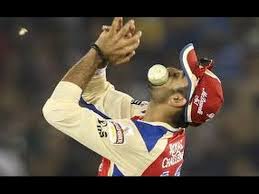
There is a nightmare scenario lurking in the future shadows of T20 cricket. It’s unexplored territory that arguably goes against the spirit of the game, like the underarm delivery or the Mankad. The possibility of it is so unpalatable that few have thus far dared think about it. The nightmare scenario is this: Will we ever see a T20 match in which a fielder deliberately drops a catch?
The reason why this might become an issue is because of scoreboard pressure. Considering the following scenario:
It is the second innings. The team batting first scored 200, and in response, the chasing team is 141/1 after 15 overs. This means that the chasing team needs 60 runs off 30 balls, a RRR of 12 per over. This is a challenging task but not ungettable. The No. 3 batsman is in, but has struggled to get the ball out of the middle all day and is striking at less than 100. The Nos. 4, 5, 6 and 7 batsmen are all established hitters who reliably strike at 125+. The No. 3 batsman has just hit the first ball of the 16th over in the air towards mid-on, who is lining it up.
The question: Is it in the interests of the fielding team for the mid-on fielder to complete the catch, or is it better for him to deliberately palm the ball into the ground?
Consider the match situation. The chasing team needs 60 runs off 30 balls, which essentially means that they have to score boundaries. The No. 3 batsman has had trouble hitting boundaries all innings, which means that the chasing team has a fair probability of losing if he remains at the wicket, because he will use up deliveries that the Nos. 4, 5, 6 and 7 batsmen could be using to strike boundaries.
If he gets out now, on the other hand, those batsmen will be able to come in and strike at a higher rate, meaning that the chasing team would have a much higher chance of winning the match.
In simpler terms, what happens when the wicket count is meaningless on account of there being so few overs left and the current striker has a lower strike rate than the next man in (or, at least, the fielding team anticipates that he will have a lower strike rate)?
Against this, it might be argued that a set batsman will have his eye in better than the next batsman in, and so taking the catch will always benefit the fielding team. Moreover, taking the catch makes it more likely that the bowlers can get into the tail.
But that doesn’t negate the possibility, however unlikely, that a match situation may arise in which the fielding team calculates that the match is unwinnable for the chasing team while a certain batsman is at the crease on account of the intensity of the scoreboard pressure.
What may happen in the end is that batsmen are simply sent to the crease in descending order of strike rate.
*
If you enjoyed reading this essay, you can get a compilation of the Best VJMP Essays and Articles of 2017 from Amazon for Kindle or Amazon for CreateSpace (for international readers), or TradeMe (for Kiwis).
